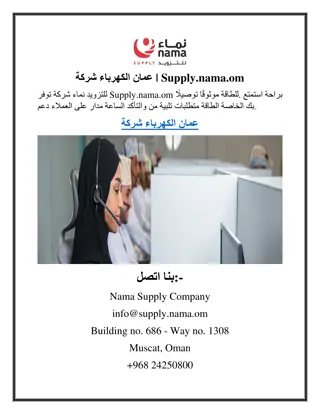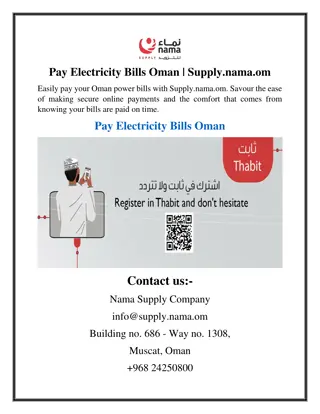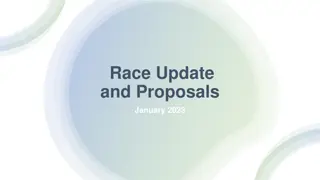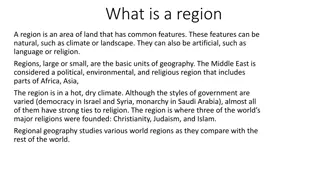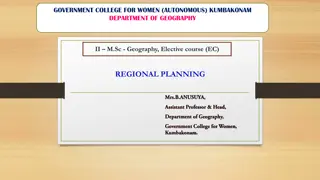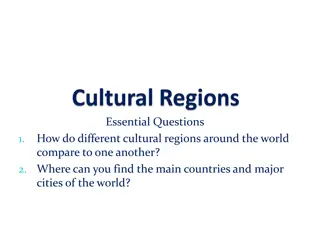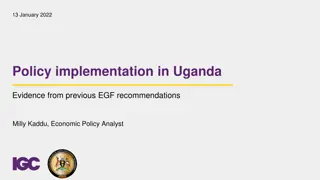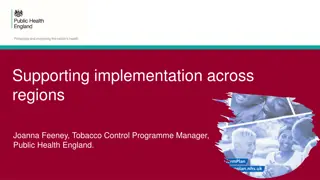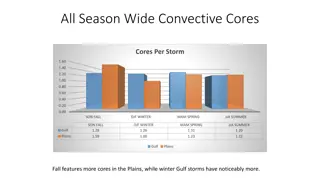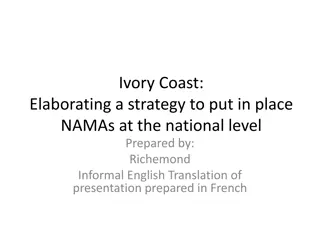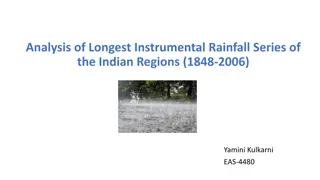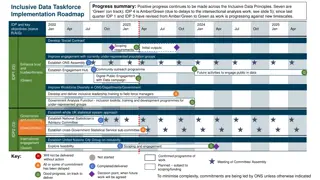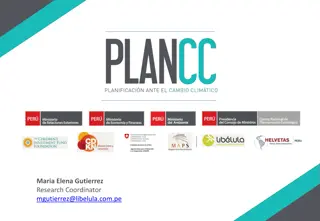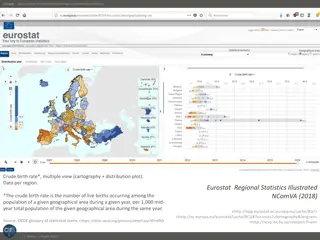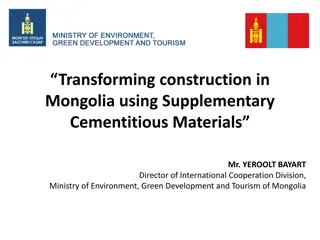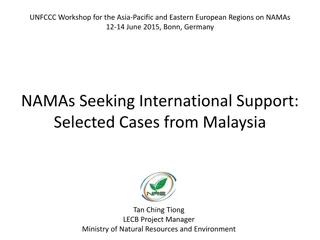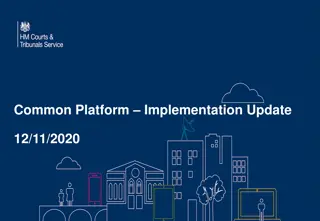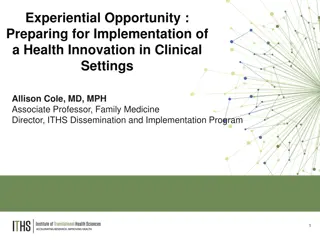Overview of NAMA Implementation and Progress Across Regions
The content discusses the status of Nationally Appropriate Mitigation Actions (NAMAs) in various regions, outlining key programs and initiatives in countries such as Colombia, Chile, Thailand, Kenya, and more. It also highlights the goals of the Mitigation Action Implementation Network aimed at creating networks of policymakers involved in NAMAs and facilitating financing for early NAMA projects. The overview covers the development and implementation of NAMAs globally, with a focus on sectors like energy, transport, forestry, waste, agriculture, industry, and buildings. Funding sources and opportunities for NAMAs are also explored, showcasing a rising trend in NAMA development.
Download Presentation

Please find below an Image/Link to download the presentation.
The content on the website is provided AS IS for your information and personal use only. It may not be sold, licensed, or shared on other websites without obtaining consent from the author. Download presentation by click this link. If you encounter any issues during the download, it is possible that the publisher has removed the file from their server.
E N D
Presentation Transcript
STATUS OF NAMA PREPARATION AND IMPLEMENTATION Gerardo Canales Manager, Latin America Projects September, 2015 UNFCCC NAMA regional workshop Santiago de Chile Dialogue. Insight. Solutions.
OUTLINE CCAP s MAIN program Status of NAMAs Colombia TOD NAMA Chile Self Supply Renewable Energy NAMA Thailand Refrigerators and A/C NAMA Renewable Energy: Kenya Geothermal NAMA Waste NAMA Green Resilience Shared Vision of Transformational NAMAs NAMA Finance is Flowing Conclusions on NAMAs 1 CCAP
MITIGATION ACTION IMPLEMENTATION NETWORK Goals: Create regional networks of policymakers involved in NAMAs (Asia, Latin America) Build national capacity to identify, design and develop financeable NAMAs Impact the design of the GCF and other NAMA/climate finance programs Facilitate financing for implementation of early NAMAs Components: 1. Regional dialogues of policymakers, experts, potential funders 2. Video conferences with policymakers 3. Harvesting of best practices, case studies, policy analysis, policy papers 4. On-the-ground support for NAMA design, in-country workshops 5. Global dialogues, policy lunches for negotiators 2 CCAP
STATUS OF NAMAS Regional overview NAMAs Under development Implementation Total Asia Europe Latin America Africa Total 31 13 56 45 145 6 0 6 1 37 13 62 46 158 13 Source: Ecofys NAMA Database September 2015 Source: Ecofys/ECN NAMA Status Mid Year update 2015 The number of NAMAs under development is rising Latin America has been most active in NAMA development The number of NAMAs under implementation is growing though small Funding has primarily come from the path breaking UK-Germany NAMA Facility The GCF presents a major new opportunity 3 CCAP
STATUS OF NAMAS Sectoral overview NAMAs Under Energy and transport NAMAs represent more than half of the portfolio development Implementation Total Energy Transport Forestry Waste Agriculture Industry Buildings Multisector 60 21 5 1 2 0 1 0 1 3 65 22 5 7 18 18 7 9 8 9 15 10 16 13 As of 2015, around 158 NAMAs are developed or in process, with at least 124 seeking implementation support 8% Energy 10% Transport Forestry 41% 6% Waste 5% Agriculture Industry Buildings 11% Multisector 5% 14% Source: Ecofys NAMA Database September 2015 4 CCAP
TRANSFORMATIONAL NAMAS Are host country-driven efforts to reduce GHGs and advance sustainable development. Apply technical assistance to surmount implementation barriers and foster replication. Finance catalytic projects for short-term results. Transform policies to sustain GHG reductions. Mobilize private investment through financing mechanisms that change the risk-return equation. Leverage public investments(e.g., infrastructure) Create a pipeline of investments for private sector, development banks and climate financiers. 5 CCAP
COLOMBIA TRANSIT-ORIENTED DEVELOPMENT (TOD) NAMA TOD focuses public and private development around transit stations to create neighborhoods where people ca walk, live, work, shop and play. Colombia TOD NAMA Catalytic local pilots and transformative policies CIUDAT housed in Findeter governed by Executive Board (Transport, Environment, Housing, Planning, Findeter, CCAP) Increase return on public and private investments Leverage $16 billion investments in public transport, social housing Help focus $500 million in Sustainable Cities funds (IDB) Help attract private real estate investment Annual savings of 3.6 to 5.4 MMTCO2e by 2040 NAMA gives Colombia ability to choose best projects that meet criteria to maximize GHG mitigation and financial leverage a model for direct access Status: Pre-selected by NAMA Facility, finalizing appraisal ITDP DOs: KfW, CCAP Implementing: FINDETER 6 CCAP
CHILE SELF SUPPLY RENEWABLE ENERGY NAMA STRUCTURE Activities Expected Outputs Components Institutions Leverage of around USD$100 million GHG reduction of 1.5 million tons of CO2e develop a bankable project pipeline Development of a bankable project pipeline Training and advisory services for financial sector Investment grants Guarantee fund Financial Component KfW CORFO SSRE NAMA Outreach and awareness Training and capacity building Technical help desk Monitoring, reporting and verification 800 people outreached 300 people trained 200 projects supported trough the technical help desk Rise a project pipeline of 200 MW for Financial Component All SSRE projects incorporated into de MRV platform Centre for Innovation & Promotion of Sustainable Energy (CIFES) Technical Component GIZ
THAILAND REFRIGERATOR AND A/C Emissions account for 20% of country total Four areas of activity Production of green equipment Servicing and use Revisions to policy and Financial Framework GreenRAC Innovation Fund: 7 X NAMA Funding Raising awareness Anticipated GHG Mitigation: 2 MtCO2e per year by 2020 46 MTCO / year by 2030 Status: In Appraisal Source: NAMA Facility DO: GIZ Implementing: DEDE and EPPO 8 CCAP
KENYA GEOTHERMAL NAMA Geothermal is best technology to keep Kenyan energy sector low-carbon NAMA Supports 850 MW expansion of private geothermal capacity by 2020 Employs technical assistance, risk guarantees for costly drilling, and capacity building 3.8 MtCO2e/yr in 2020 Enhance climate resilience Status: In Development Partner: ECN Policy Studies 9 CCAP
WASTE NAMAS Source: Mitigation Partnership Source: CCAP Source: Mitigation Partnership Shift Solid Waste Management to waste reduction alternatives to reduce landfilling Create equity fund to support alternative projects Regulatory changes (e.g., increased tariffs, landfill tax charges) to make alternative technologies economic Mitigation: significant sectoral reduction if fully implemented Status: Under development in several countries 10 CCAP
GREEN RESILIENCE OPPORTUNITIES: ADAPTATION + MITIGATION SYNERGIES 11
CLIMATE FINANCE IS FLOWING NAMA Facility Pre-selected 4 projects in its 2nd round, announced in Lima: Burkina Faso Biomass Energy Peru Sustainable Urban Transport Tajikistan Forestry NAMA Thailand Refrigeration and AC Denmark and EC have joined to support 85 million 3rd round Third call for proposals was opened through July 15, 2015. 42 project proposals submitted, of which 45% from Africa, by far the most of the three rounds. Has demonstrated demand for NAMA finance Green Climate Fund (GCF) GCF operationalization holds great promise for NAMAs $10.3 Billion USD pledged to date Board expected to select first programs/projects in fall 2015 $6 billion of initial resources need to be spent by 2017 to start next replenishment. 200 x $ 10 million projects = $2 billion 25 x $ 40 million programs = $ 2 billion 10 x $200 million programs = $ 2 billion 12 CCAP
GCF AND UK-GERMAN NAMA FACILITY HAVE SIMILAR SELECTION CRITERIA Both selection processes are competitive with similar criteria: Paradigm Shift / Transformational ambition strong regulatory framework Sustainable Development Country Ownership Catalyze private sector investment GHGs Need (GCF only) GCF requires 50% of finance flows to adaptation and half of that to LDCs (NF finances only mitigation) 13 CCAP
CONCLUSIONS ON NAMAS NAMAs should be bold They should transform existing structures that prevent mitigation (e.g. fossil fuel subsidies, anti-competitive regulations, etc.) and create policies that drive low carbon outcomes NAMAs should be at a program scale By funding programs, rather than specific projects, the funder can achieve greater scale, replication, and overall ambition. Programs should incorporate policy changes, new financial mechanisms, and some bankable projects. Host country institutions should be empowered to select additional domestic projects, based on program criteria that the funder has approved (rather than the funder making investment decisions on each specific project) NAMAs should not only leverage private sector and other funding but also demonstrate paradigm shift . Need to avoid business as usual proposals that show leverage but not transformation. 14 CCAP
NAMAS IN A POST-2015 CONTEXT Investment Strategy Selection for funding INDCs NDC Many INDCs are likely to be quantitative but may not include specifics on sector-specific policies Some developing countries are likely to propose INDCs with elements conditional on international support Conditional INDC elements will likely need to be translated into investment strategies after Paris for consideration by GCF and others The NAMA Facility has served as an important laboratory it could continue to test bold ideas on financing and NAMA design in the future To increase ambition, need a competitive race to the top -- GCF provide the carrot for transformation 15 CCAP
THANK YOU For more information, please visit us at www.ccap.org



